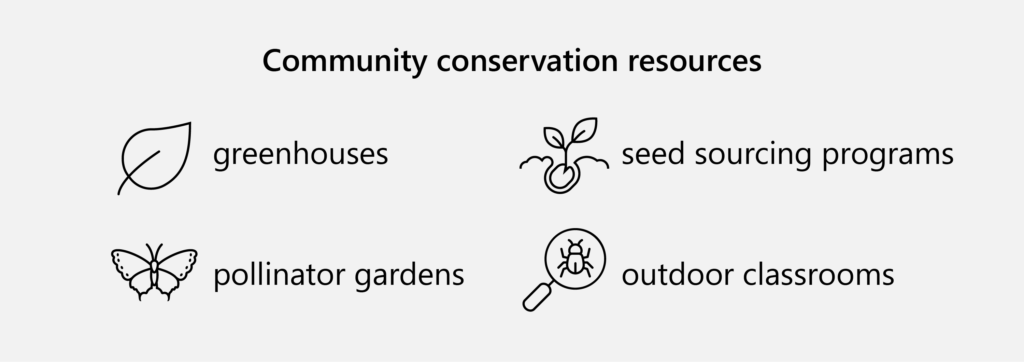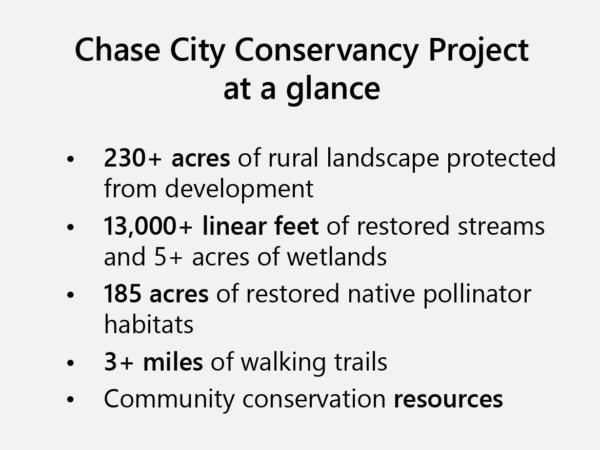Restoring native habitat as a community space for Chase City, Virginia
As part of our commitment to be a responsible steward of the environment, Microsoft is designating over 230 acres of rural landscape in Virginia for restoration and conservation. The Chase City Conservancy Project will restore wetlands, streams, and native pollinator habitats and conserve forest and grasslands on a large plot of land Microsoft has purchased for a new datacenter facility south of Chase City, Virginia.
The Chase City Conservancy Project
The Chase City Conservancy Project’s 230 acres traverses rolling hills, grasslands, former pastureland, bluffs, and forest. The conservation area will become home to restored native pollinator habitats, three miles of public walking trails, and a learning center for K-12 students and the Chase City community. The Conservancy Project will also remediate waterways and wetlands degraded by dairy farming, with the aim to restore over five acres of wetlands and 13,000 linear feet of streams.
The Conservancy Project is designed to serve as a community resource and recreation area for Mecklenburg County. The conservation site borders a residential neighborhood, making it accessible to the local community for walks on the public trails and educational areas. “People can come to the walking trails with their moms and dads and grandmas on the weekend, walk the trail, and visit trees they have planted,” explains Microsoft Environmental Permitting Program Manager Alexis Jones, who conceived of the Chase City Conservancy Project. The datacenter facilities will be tucked away to the north of the 600-acre site, with a forested corridor serving as a visual buffer for local residents.
Key programs of the Conservancy Project include habitat restoration, regenerative agriculture practices, and public recreation and learning:
Creating habitats that support biodiversity
- Restore and preserve 45 acres of wetlands and streams.
- Establish 130 acres of native grasslands and pollinator habitat.
- Reforest an additional 35 acres of land.
- Host community and student tree planting events.
As part of the tree-planting effort, Microsoft donated two state-of-the-art greenhouses at the Mecklenburg County Public Middle School and High School Complex and provided 22 raised garden beds at local schools. In partnership with the Department of Forestry, the Conservancy is developing a K-12 curriculum encouraging children to learn about trees, cultivate seedlings from acorns, plant and monitor their seedlings’ growth, and experiment with different cultivation methods (like compost versus leaf litter and raised bed versus open ground). Students cultivate pollinator plants such as butterfly weed and milkweed from seed in their raised beds and then plant them at the Conservancy.
Promoting regenerative agriculture
- Sponsor hydroponic growing stands or “garden towers” at all Mecklenburg County Public Schools elementary schools.
- Share regenerative land best practices.
- Develop programs that foster environmental sustainability awareness.
The Conservancy is applying regenerative agriculture solutions to encourage biodiversity, improve water quality, and increase plant productivity. The regenerative agriculture program designates various acres for exploring diversified agricultural efforts. The Farm Bureau has offered matching funds to support youth agricultural education initiatives.
Developing space for outdoor recreation and learning
- Establish 3 miles of public walking trails with integrated learning stations.
- Create an outdoor classroom for environmental learning.
Microsoft welcomes neighbors to experience the land and learn more about pollinators, vegetation ecosystems, butterfly stopovers, and natural resources management.

Microsoft has secured permits from the Army Corps of Engineers and the Virginia Department of Environmental Quality for the development of datacenter facilities on the 600-acre Chase City site where the 230-acre conservation area is located. The Chase City Conservancy Project is designed to exceed federal and state environmental mitigation requirements.


